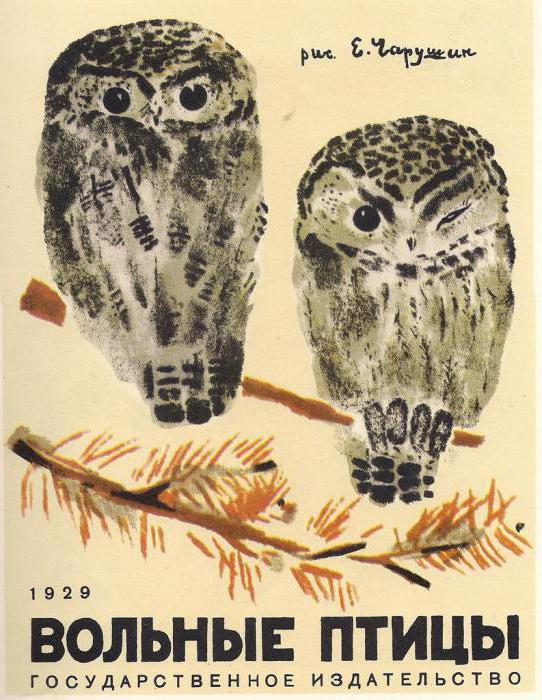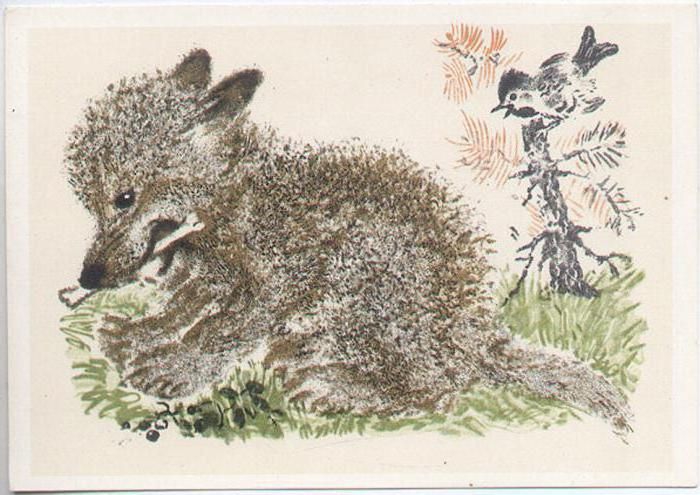The work of Evgeny Charushin, humane, kind, pleases several generations of young readers, teaches children to love the magical world of birds and animals.
Charushin Evgeny Ivanovich, whose biography is presented in this article, is a graphic artist and writer. The years of his life - 1901-1965. On October 29, 1901, Yevgeny Charushin was born in Vyatka. A photo of him is presented below.
Father Evgeny Ivanovich - Charushin Ivan Apollonovich - provincial architect, one of the best architects of the Urals. More than 300 buildings in Izhevsk, Sarapul, Vyatka were built according to his designs. Like any architect, he was a good draftsman. The family of Ivan Apollonovich lived very friendly. The house often gathered artists, musicians. Parents from childhood instilled in their son a love of nature.
Favorite book of Charushin
Eugene’s favorite reading books were books about our smaller brothers. "Life of animals" A.E. Brema was for him the most dear and beloved. He re-read it all his life. In the fact that the aspiring artist portrayed more and more birds and animals, there is a significant share of Brem's influence. Charushin began to draw early. The novice artist went to a scarecrow workshop, which was nearby, or watched the animals at home.
Sopohud
At age 14, he and his comrades organized the union of artists and poets "Sopohud." Eugene from a young age wanted to capture what he saw in order to preserve a rapidly changing world. And drawing came to the rescue. Evgeny Ivanovich said that the artist was born in him earlier than the writer. A little later came the right words.
Work in the Political Department of the headquarters, study at the Academy of Arts
In 1918, Evgeny Charushin graduated from high school in Vyatka. He studied in it with Yuri Vasnetsov. Then Evgeny Ivanovich was drafted into the army. Here they decided to use it "by specialty" - they appointed him an assistant decorator in the Political Department of the headquarters. After serving 4 years, almost the entire civil war, Evgeni Ivanovich only returned in 1922.
He decided to study as an artist. In winter, he studied at the workshops of the Vyatka Provincial Commissariat, and in the same year, in the fall, he entered VKhUTEIN (Petrograd Academy of Arts), at the painting faculty. Yevgeny Charushin studied here for five years, from 1922 to 1927. His teachers were A. Karaev, M. Matyushin, A. Savinov, A. Rylov. However, as Yevgeny Ivanovich later recalled, these were the most barren years for him. Charushin was uninterested in the search for a new word in painting, as well as academic drawing. It was much more pleasant to go to the bird market or to the zoo. The young artist at that time loved to dress in fashion. According to the memoirs of Valentin Kurdov, his close friend, he went in colorful stockings and golfs, wore a fawn cap and a short motley fur coat of dog fur.
Traveling, working in the Leningrad State Publishing House
Using the advice of V. Bianchi, in 1924, Evgeny Charushin went to Altai on an exciting journey with Valentin Kurdov and Nikolai Kostrov.
In 1926, Charushin joined the Leningrad State Publishing House, in the children's department, which was headed by Vladimir Lebedev, a famous artist. The artists in those years were tasked with creating for the little inhabitants of the Soviet Union fundamentally new books, highly artistic, but at the same time informative and informative. Lebedev liked the painted animals of Charushin, and he began to strongly support him in his creative pursuits.
Collaboration in magazines, first illustrations for books
Evgeny Ivanovich by that time (since 1924) was already working at Murzilka, a children's magazine. A little later, he began working in the "Hedgehog" (from 1928 to 1935) and in the "Cizha" (from 1930 to 1941). Evgeny Charushin received in 1928 his first order from the Leningrad State Publishing House - to issue the story "Murzuk" by V.V. Bianchi. The first book with his drawings attracted the attention of both young readers and connoisseurs of book graphics. The illustration from it was acquired by the State Tretyakov Gallery itself.

Charushin in 1929 illustrated several more books: "Free Birds", "Wild Animals", "How a Bear Becomes a Big Bear." In these works, Yevgeny Charushin's extraordinary skill in transmitting animal habits was fully manifested. Orphaned little teddy bear sitting on a branch; a scruffy crow who was about to peck a bone; wild boars, wandering with babies ... All this and much more are drawn expressively, vividly, but at the same time capacious and concise. The artist, creating the image of the animal, was able to highlight the most important, characteristic features.
The first stories of Evgeny Charushin
Many illustrations were made by Evgeny Charushin. The works of Bianchi, as well as S. Ya. Marshak, M. M. Prishvin and other famous writers with his drawings attracted many readers. At the same time, at the insistence of Marshak, he tried to compose small children's stories about the life of animals. His first story appeared in 1930 ("Schur"). Already in this work not only an excellent knowledge of the characters of various animals was manifested, but also a sense of humor. In all the other stories of Yevgeny Ivanovich, a mischievous, sometimes soft, sometimes slightly ironic, or kindly condescending smile is also palpable. Charushin Evgeny Ivanovich - an illustrator and writer who sought to understand the animals, their facial expressions and movements. The accumulated experience helped him convey this in words and illustrations. There is no fiction in what Yevgeny Ivanovich created - animals always do what is characteristic of them.
New books of Charushin and illustrations for them
Charushin Evgeny Ivanovich, whose paintings were very famous at that time, began to illustrate now his own compositions: “Various animals” (1930), “Volchishko and others”, “Nikita and his friends”, “About Tomka”, “About big and small "," My first zoology "," Vaska "," Medvezhata "," About the magpie ", etc. However, this turned out to be the most difficult, since, by the personal admission of Yevgeny Ivanovich, it was much easier for him to illustrate other people's texts than own. In the 1930s, Charushin was recognized as one of the best artists specializing in children's books. At that time, its design had already developed in a separate direction in art. About stories Charushina very warmly responded M. Gorky. Working in the technique of color or monochrome watercolor drawing, Evgeny Ivanovich recreated an entire landscape environment with one light dynamic spot. His animal stories are elegant and lexically simple.
More on the work of Charushin
With great respect, Charushin treated his readers. He was glad that the animals he painted were not liked by the editors and critics, but by the kids. Considering the books of Charushin, we can safely say that both the illustrations and the texts themselves reflect the whole, single inner world of their creator. Drawings and stories are informative, concise, strict and understandable to anyone, even a small child. In the collection "Chicks" (1930), consisting of short stories about owls, bark beetles, and mountain grouse, Evgeni Charushin masterfully highlights the most catchy and memorable features of the characters.

Charushin knew well the habits of animals. In the illustrations, he depicted them with extraordinary character and accuracy. Each of his drawings is individual, in each of them the character is depicted with his own special character, which corresponds to a particular situation. Charushin responsibly solved this problem. He said that if there is no image, there is nothing to portray. Charushinsky animals are emotional, touching. Background and medium are barely outlined in his early books. The main thing is to show the animal in close-up, while not only creating an artistic image, but also portraying the hero as truthfully as possible. Evgeny Ivanovich did not like animals poorly drawn from the point of view of biology. He also believed that the drawings in the children's book should be breathable, alive. Yevgeny Charushin did not like Ivan Bilibin, believing that he was engaged not in drawing, but in painting dead, cold contours.
Of the many textures, picturesque images of Charushin's animals are formed, which masterfully convey the fur of the beast, feathers of the bird. To create picturesque in texture, complex drawings was most conveniently in the technique of lithography. Most often, the artist used natural pastel colors. He did not recognize the lithographic rules and laws, temperamentally leading with a pencil, scratching the lithographic stone with a razor and a needle. For many times, Evgeny Ivanovich could glue up the not obtained parts in the picture or cover them with white.
About 20 books were created in the pre-war era by Evgeny Charushin. His biography was marked by the appearance of the following works: 1930 - "Chicks"; in 1931 - “Volchishko and others”, “Chicken city”, “Round-up”, “Jungle - bird's paradise”; in 1935 - "Animals of hot countries." At the same time, he continued to illustrate such authors as S. Ya. Marshak, V.V. Bianchi, M. M. Prishvin, A. I. Vvedensky.
War years
During the war, Charushin was evacuated from Leningrad to Kirov (Vyatka), to his homeland. Here he created partisan-themed paintings, painted posters, designed performances, painted the walls of the kindergarten and foyer of the House of Schoolchildren and Pioneers, and taught children how to draw.
Charushin Evgeny Ivanovich: a brief biography of the postwar years
The artist returned to Leningrad in 1945. In addition to working on books, he began to create a series of prints depicting animals. Charushin became interested in sculpture before the war. He painted tea sets, and then, in peacetime, he created animal figures from porcelain and even whole decorative groups. He tried a different approach to the design of books for children. In the drawings of Charushin, a perspective began to appear, space began to be designated. The technique also changed: he began to work with watercolors and gouache, but not with wide strokes, but he worked out very carefully small details. In 1945, Charushin became an Honored Artist of the RSFSR.
The last book he illustrated was "Children in a Cage" by Samuel Yakovlevich Marshak. Charushin’s works are now translated into many languages of the peoples of the former USSR, as well as a number of foreign countries. His prints, illustrations, books, porcelain sculpture were exhibited at exhibitions in Paris, London, Sofia. The total circulation of books by Evgeny Charushin exceeds 60 million copies.
On February 18, 1965, Eugene Charushin died in Leningrad. He was buried at the Theological Cemetery.